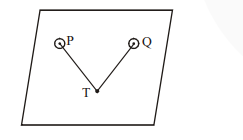Let the position vectors of two points $P$ and $Q$ be $3 \hat{\mathrm{i}}-\hat{\mathrm{j}}+2 \hat{\mathrm{k}}$ and $\hat{\mathrm{i}}+2 \hat{\mathrm{j}}-4 \hat{\mathrm{k}}$, respectively. Let $\mathrm{R}$ and $\mathrm{S}$ be two points such that the direction ratios oflines PR and QS are $(4,-1,2)$ and $(-2,1,-2)$, respectively. Let lines PR and $\mathrm{QS}$ intersect at $\mathrm{T}$. If the vector $\overrightarrow{\mathrm{TA}}$ is perpendicular to both $\overrightarrow{\mathrm{PR}}$ and $\overrightarrow{\mathrm{QS}}$ and the length of vector $\overline{\mathrm{TA}}$ is $\sqrt{5}$ units, then the modulus of a position vector of $A$ is :
Correct Option: , 2
$\mathrm{P}(3,-1,2)$
$\mathrm{Q}(1,2,-4)$
$\overline{\operatorname{PR}} \| 4 \hat{\mathrm{i}}-\hat{\mathrm{j}}+2 \hat{\mathrm{k}}$
$\overline{\mathrm{QS}} \|-2 \hat{\mathrm{i}}+\hat{\mathrm{j}}-2 \hat{\mathrm{k}}$
dr's of normal to the plane containing $\mathrm{P}, \mathrm{T} \& \mathrm{Q}$ will be proportional to :
$\left|\begin{array}{ccc}\hat{\mathrm{i}} & \hat{\mathrm{j}} & \hat{\mathrm{k}} \\ 4 & -1 & 2 \\ -2 & 1 & -2\end{array}\right|$

$\therefore \quad \frac{\ell}{0}=\frac{\mathrm{m}}{4}=\frac{\mathrm{n}}{2}$
For point, $\mathrm{T}: \overrightarrow{\mathrm{PT}}=\frac{\mathrm{x}-3}{4}=\frac{\mathrm{y}+1}{-1}=\frac{\mathrm{z}-2}{2}=\lambda$
$\overrightarrow{\mathrm{QT}}=\frac{\mathrm{x}-1}{-2}=\frac{\mathrm{y}-1}{1}=\frac{\mathrm{z}+4}{-2}=\mu$
$\mathrm{T}:(4 \lambda+3,-\lambda-1,2 \lambda+2)$
$\cong(2 \mu+1, \mu+2,-2 \mu-4)$
$4 \lambda+3=-2 \mu+1 \Rightarrow 2 \lambda+\mu=-1$
$\lambda+\mu=-3 \quad \Rightarrow \quad \lambda=2$
$\& \mu=-5 \quad \lambda+\mu=-3 \quad \Rightarrow \quad \lambda=2$
So point T : $(11,-3,6)$
$\overrightarrow{\mathrm{OA}}=(11 \hat{\mathrm{i}}-3 \hat{\mathrm{j}}+6 \hat{\mathrm{k}}) \pm\left(\frac{2 \hat{\mathrm{j}}+\hat{\mathrm{k}}}{\sqrt{5}}\right) \sqrt{5}$
$\overrightarrow{\mathrm{OA}}=(11 \hat{\mathrm{i}}-3 \hat{\mathrm{j}}+6 \hat{\mathrm{k}}) \pm(2 \hat{\mathrm{j}}+\hat{\mathrm{k}})$
$\overrightarrow{\mathrm{OA}}=11 \hat{\mathrm{i}}-\hat{\mathrm{j}}+7 \hat{\mathrm{k}}$
Or
$9 \hat{\mathrm{i}}-5 \hat{\mathrm{j}}+5 \hat{\mathrm{k}}$
$|\overrightarrow{\mathrm{OA}}|=\sqrt{121+1+49}=\sqrt{171}$
Or
$\sqrt{81+25+25}=\sqrt{131}$
Click here to get exam-ready with eSaral
For making your preparation journey smoother of JEE, NEET and Class 8 to 10, grab our app now.
